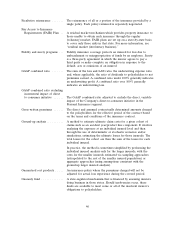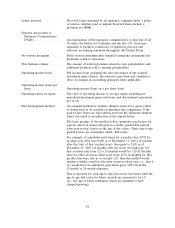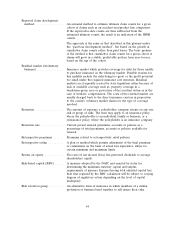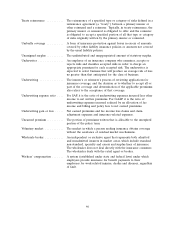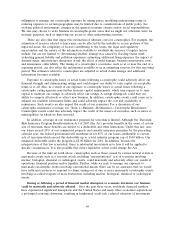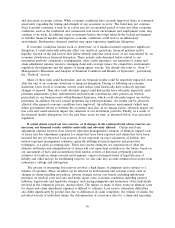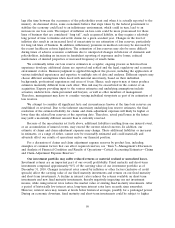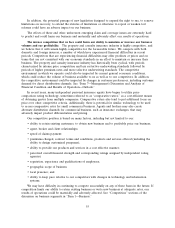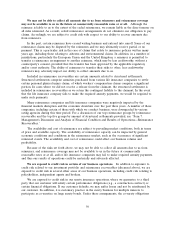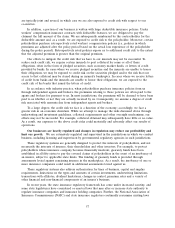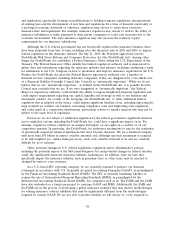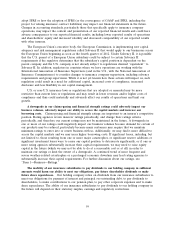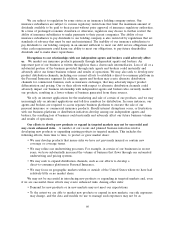Travelers 2010 Annual Report Download - page 62
Download and view the complete annual report
Please find page 62 of the 2010 Travelers annual report below. You can navigate through the pages in the report by either clicking on the pages listed below, or by using the keyword search tool below to find specific information within the annual report.lags (the time between the occurrence of the policyholder event and when it is actually reported to the
insurer). As discussed above, some economists believe that steps taken by the federal government to
stabilize the economy could lead to an inflationary environment, which could in turn, lead to an
increase in our loss costs. The impact of inflation on loss costs could be more pronounced for those
lines of business that are considered ‘‘long tail’’, such as general liability, as they require a relatively
long period of time to finalize and settle claims for a given accident year. Changes in the level of
inflation also result in an increased level of uncertainty in our estimation of loss reserves, particularly
for long tail lines of business. In addition, inflationary pressures in medical costs may be increased by
the recent healthcare reform legislation. The estimation of loss reserves may also be more difficult
during times of adverse economic conditions due to unexpected changes in behavior of claimants and
policyholders, including an increase in fraudulent reporting of exposures and/or losses, reduced
maintenance of insured properties or increased frequency of small claims.
We continually refine our loss reserve estimates in a regular, ongoing process as historical loss
experience develops, additional claims are reported and settled and the legal, regulatory and economic
environment evolves. Business judgment is applied throughout the process, including the application of
various individual experiences and expertise to multiple sets of data and analyses. Different experts may
choose different assumptions when faced with material uncertainty, based on their individual
backgrounds, professional experiences and areas of focus. Hence, such experts may at times produce
estimates materially different from each other. This risk may be exacerbated in the context of an
acquisition. Experts providing input to the various estimates and underlying assumptions include
actuaries, underwriters, claim personnel and lawyers, as well as other members of management.
Therefore, management may have to consider varying individual viewpoints as part of its estimation of
loss reserves.
We attempt to consider all significant facts and circumstances known at the time loss reserves are
established or reviewed. Due to the inherent uncertainty underlying loss reserve estimates, the final
resolution of the estimated liability for claims and claim adjustment expenses will likely be higher or
lower than the related loss reserves at the reporting date. Therefore, actual paid losses in the future
may yield a materially different amount than is currently reserved.
Because of the uncertainties set forth above, additional liabilities resulting from one insured event,
or an accumulation of insured events, may exceed the current related reserves. In addition, our
estimate of claims and claim adjustment expenses may change. These additional liabilities or increases
in estimates, or a range of either, cannot now be reasonably estimated and could materially and
adversely affect our results of operations and/or our financial position.
For a discussion of claims and claim adjustment expense reserves by product line, including
examples of common factors that can affect required reserves, see ‘‘Item 7—Management’s Discussion
and Analysis of Financial Condition and Results of Operations—Critical Accounting Estimates—Claims
and Claim Adjustment Expense Reserves.’’
Our investment portfolio may suffer reduced returns or material realized or unrealized losses.
Investment returns are an important part of our overall profitability. Fixed maturity and short-term
investments comprised approximately 94% of the carrying value of our investment portfolio as of
December 31, 2010. Changes in interest rates caused by inflation or other factors (inclusive of credit
spreads) affect the carrying value of our fixed maturity investments and returns on our fixed maturity
and short-term investments. A decline in interest rates reduces the returns available on short-term
investments and new fixed maturity investments, thereby negatively impacting our net investment
income, while rising interest rates reduce the market value of existing fixed maturity investments. After
a period of historically low interest rates, long-term interest rates have recently risen somewhat.
However, interest rates may remain at levels below historical averages, possibly for a prolonged period.
During an economic downturn, fixed maturity and short-term investments could be subject to higher
50


